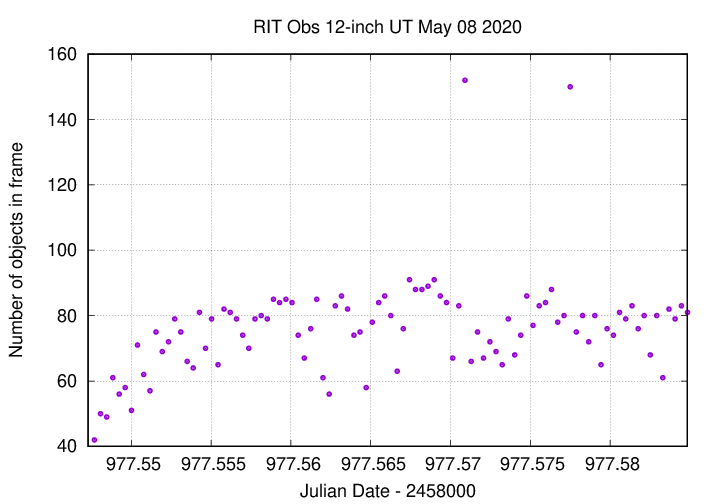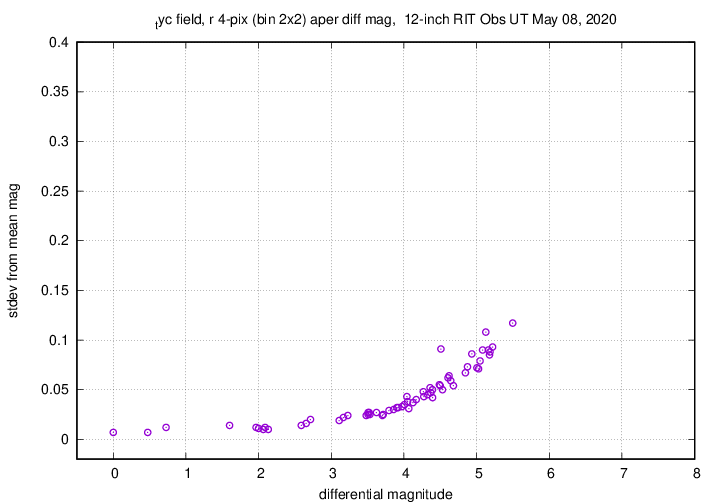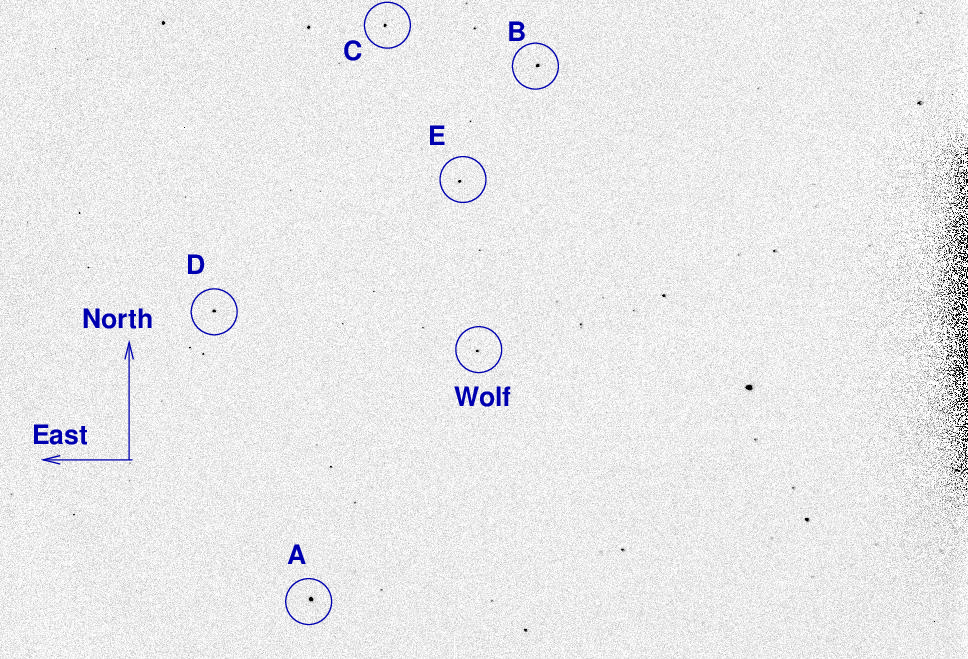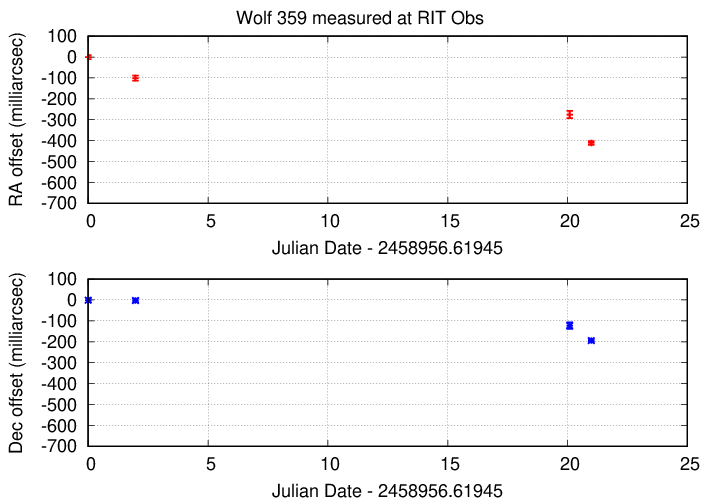
On the night of May 07/08, 2020, under good conditions, I acquired two sets of observations. First, a short set of measurements of the eclipsing binary system TYC 2483-160-1 to support a study of possible exoplanets around it. Last night, I made measurements during an eclipse, but tonight, I simply needed a few measurements of the system to set its baseline magnitude out of eclipse. after that, another set of images of Wolf 359, as part of the the New Horizons parallax project.
The AAVSO Alert which appeared on May 06, 2020, requested observations of the system TYC 2483-160-1.
Exoplanet researchers Dr. Veselin Kostov and his collaborators at NASA Goddard, and Prof. Bill Welsh and Dr. Jerome Orosz at San Diego State University, have issued a request for immediate help in observing the primary eclipse of a new candidate TESS circumbinary system – namely one where an exoplanet is orbiting an eclipsing binary.
I made measurements last night during the eclipse and sent them to Dr. Orosz. He noted that all my measurements were during the eclipse, and asked it I could make additional measurements tonight in order to set the baseline level of the system out of eclipse.
The main setup was:
Notes from the night:
I decided to use the guider, but NOT to run Remote Desktop, as a test. There were no problems with MaximDL, so this suggests that the freezing issue may be related to Remote Desktop. It is inconvenient to be unable to see the MaximDL screen without walking outside to the dome, though.
The object is at position
RA = 08:34:38.8 Dec = +31:33:15 (J2000)
A chart of the field is shown below. The size of the chart is about 41 x 27 arcminutes. The noisy area at right (West) is the shadow of the guider's pickoff mirror.

I've marked the location of several comparison stars, which also appear in light curves below.
star UCAC4 B V r RIT "r" ------------------------------------------------------------------------- A UCAC4 608-044531 10.231 9.715 9.624 9.624(*) B UCAC4 608-044511 12.241 11.724 11.607 11.712 C UCAC4 608-044515 12.806 12.336 12.246 12.337 D UCAC4 608-043052 12.875 12.312 12.176 12.278 E UCAC4 607-042934 10.889 10.315 10.194 10.350 X UCAC4 607-042891 aka YY Cnc 11.003 11.224 TYC UCAC4 608-044517 aka the target 10.097 --------------------------------------------------------------------------
The column labelled RIT "r" is based on the ensemble photometry solution from tonight (UT 2020 May 08), shifted so that star "A" has its "r"-band magnitude from the UCAC4 catalog.
I ran the camera at -20 C. Nothing out of the ordinary.

The sky value shows a strong decrease at the start, as I began during dusk.

Here's a record of the telescope's drift. I was using the guider during these observations, but the telescope's Dec motor suffers from backlash, so it doesn't track very well in Dec.

The number of objects detected.

I used an aperture with radius 4.0 pixels tonight.

Below is the ensemble zeropoint as a function of time.

Using aperture photometry with a radius of 4 pixels (binned 2x2, each pixel is 1.24 arcsec, so a radius of 5.0 arcsec), I measured the instrumental magnitudes of a number of reference stars and the target. Following the procedures outlined by Kent Honeycutt's article on inhomogeneous ensemble photometry, I used all stars available in each image to define a reference frame, and measured each star against this frame.
Sigma-vs-mag plots show that the floor was about 0.007 mag overall.

Here are light curves of the variable and the field stars. The target doesn't change at all, since the eclipse happened last night, not this night.

I used the AAVSO value for the r-band magnitude of star "A" to shift the ensemble magnitudes to the standard r-band scale (even though I used an "R" filter).
I've computed the magnitude of the target based on the ensemble photometry. The first few lines of an ASCII datafile are shown below; you can download the entire file from the link after it. I've submitted my measurements to the AAVSO.
# Measurements of TYC-2483-160-1 made at RIT Obs, UT 2020 May 8, # in good conditions, # by Michael Richmond, # using Meade 12-inch LX200 and ATIK 11000. # Exposures 20 seconds long, r filter. # Tabulated times are midexposure (FITS header time - half exposure length) # and accurate only to +/- 1 second (??). # 'mag' is a differential magnitude based on ensemble photometry # using a circular aperture of radius 4 pix = 5.0 arcseconds. # which has been shifted so UCAC4 608-044531 has mag=9.624 # which is its r-band magnitude according to UCAC4. # # UT_day JD HJD mag uncert May08.04730 2458977.54730 2458977.54586 10.096 0.011 May08.04769 2458977.54769 2458977.54625 10.100 0.011
As described in the New Horizons Parallax Program,
On April 22 and 23, New Horizons will take images of two of the very nearest stars, Proxima Centauri and Wolf 359. When combined with Earth-based images made on the same dates, the result will be a record-setting parallax measurement yielding 3D images of these stars popping out of their background star fields that the New Horizons project will share with the public.
I have taken image of this field earlier:
I decided to take another set of images, in order to check my measurement routines.
I took a photo of the finder TV's screen when pointing to Wolf 359; this could be a useful reference for the future:

The object WAS located at this position in 2000,
RA = 10:56:28.8 Dec = +07:00:52 (J2000)
but since it has such high proper motion (about 4.5 arcsec per year), it is now closer to RA = 10:56:23.6 and Dec = +06:59:58.3
A chart of the field is shown below. The size of the chart is about 41 x 27 arcminutes. The noisy area at right (West) is the shadow of the guider's pickoff mirror.

I've marked the location of several comparison stars, which also appear in light curves below. In particular,
star UCAC4 B V r ----------------------------------------------------------- A 485-052029 10.530 10.157 10.122 -----------------------------------------------------------
I took a series of 80 exposures of the field, using the R-band filter and an exposure time of 20 seconds. The field wasn't too low in the sky.
Using the same techniques as described for earlier nights, I matched detected stellar positions to the Gaia DR2 catalog; this time, I used a linear model and included all stars in the catalog. The resulting positions show a mildly significant change compared to those of April (significant at the one-to-two sigma level). The differences in position correspond nearly exactly to the known proper motion.
The measurements look a bit ratty if we plot one symbol for the position determined in each image ...

... but not so bad if we plot the average position for each night.

If we plot position vs. time, the proper motion should be easy to measure -- right?

Last modified 5/08/2020 by MWR.